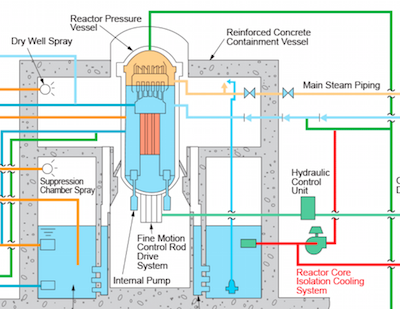
A new nuclear power station reactor design is currently going through the regulatory approval process in the UK.
Part of the consultation process enables anyone to make comments which the proponents then respond to, with the questions and responses being seen by the regulators.
I submitted the following question:
Why are the control rods not on top of the reactor so they can fall in under gravity if systems fail?
On the 11th of January 2017 I received the following response:
Thanks for your comment.
We can reassure you that in the event of an unexpected incident, the reactor can be quickly and easily be shut down using quick-acting systems with diverse back-ups.
Different reactor designs incorporate different means of achieving this rapid shut-down, and control rod insertion from below the core is standard on BWRs, as the overall design of the reactor makes insertion from the top impracticable, due to components above the core inside the pressure vessel. As such, insertion from below is most appropriate, which has the added advantage of simplifying the fuel assemblies’ replacement during refuelling.
The emergency shutdown system hydraulically inserts the control rods very rapidly, using high-pressure water stored in nitrogen charged accumulators and is a ‘fail-safe’ design – meaning that control rods are automatically inserted if power supplies are lost. This is a well-proven system of simple design, which gives equivalent high reliability, speed of function, and effectiveness in a range of scenarios (for example, loss of station power) to comparable gravity driven systems used in other designs.
In addition, there are several back-up systems for this reactor shut down function, including the use of electric motors to insert the control rods, and a completely diverse borated water injection system.
As with all aspects of the UK ABWR design, this will be assessed by the UK regulators to ensure the design fully meets UK safety expectations, including the ALARP principle (of ensuring risk is As Low As Reasonably Practicable).
In all cases, the UK ABWR has emergency shutdown procedures which prioritise the safety of workers, communities and the environment, and are in line with international best practice.
We wish above answwers to your query.
With best wishes,
UK ABWR GDA Comment Process Team
My view is the reliance on a hydraulic system to insert the control rods does not amount to a fail-safe system as if the hydraulic system fails the rods will not fall into the reactor. I would like to see reactors designed so that if services such as hydraulics, compressed nitrogen, water, external power etc. fail the reactor shuts down. I think it is more likely that a hydraulic system would fail than gravity would cease to act on the control rods.
I support the use of safe nuclear energy. Hopefully my question will have raised the matter in the minds of the regulators and elected representatives and they will insist on only allowing the safest designs of reactor to be operated.
2 responses to “Control Rods Won’t Fall Into Proposed Nuclear Power Station Reactors If Systems Fail”
I mentioned my MP when tweeting about this article
And no graphite tips!! Always a bad move on those control rods!!